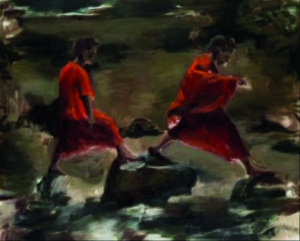
Curses
Lynette Yiadom-Boakye was born in London (1977) of Ghanaian parents. She attended St Martins School of Art & Design (1996/7)Falmouth Art College (1997-2000)and the Royal Academy Schools (2000-2003). She is represented in several public collections including Tate UK, MoMA New York and Royal Academy UK
This show seems to be an attempt to make art history uncanny – to offer us comfortable signifiers of academic portraiture and then to take away the reassurances that we might find in a national gallery. The effect is to disorient and disarm the viewer by placing us in a situation for which we have no confidence in our expectations. By playing the usual tropes against themselves the artist highlights our assumptions, and inhibits the complacency and lazy viewing that we might settle into in a ticketed museum.

A central thrust seems to be the unravelling of the unconscious. The compositions are distinguished by their shared ambiguity. While every figure is black, that is the only thing we can be sure of. Neither the backgrounds nor the figures’ dress, features, or pose give any clear indication of time, place, social class, or any other demographic that is so often the crux in art history. This uncertainty infects the viewer – a few of the images had features that looked to me as though they were painted from white models, and I left not sure if this were true or if it reflected my own schemas and biases. Further, if this was something I brought to the painting – where did it come from? Was it my own, a contingency of my experience, or a component of a vast ideology shared by others? The experience of not having clear signs by which to prejudge is highlighted here by how unusual and uncomfortable it is.
The use of explicit academic references is possibly first and foremost a critique of art history, yet one of the most compelling narratives of the show is the struggle to fully render black skin in Dutch oil pallets – taking the black figure from background exotic token to the central concern, and in doing so moving from the rough shod approximation of dark skin to a primary exhibit. The dearth of paintings of black people makes the task a challenge and while Rembrandt and Rubens both made at least one serious study of dark skin, the majority of depictions in academic figurative painting are a ‘black magus’ in a crowded scene that lack the devotion to the subject found in portraiture. It seems that Boakye is not only exploring the social history of art, but also searching for a pallet then, and her journey takes her from El Greco to Manet.
The references are usually ironic: The Casper David Friedrich pastiche gives ‘the counter’ an irony: the figure looks out on what might be a dramatic wasteland. ‘Curses’ looks like an El Greco in its brushwork but paints an

ordinary scene in the style of his rapture. Manet’s Olympia is swapped for an indeterminate figure lain topless with an arresting title: ‘yes officer, no officer’. The reference point I found most engaging, though, is the nod to Goya in the paintings ‘Hightower’ and ‘Confidences’ – there is grace in using the ashen black tones of the great protest painter.
Other writers have seen Modernism in the anti-realism of her compositions, but I rather think there is something closer to Mannerism in these paintings. The same impasse – the sense that we have arrived at the end of art history – afflicts this work. The Mannerists felt that all of the problems of painting had been solved and were therefore left with nothing to do but ghastly virtuosity copying the achievements of the recent past. And Yoadim-Boakye’s painting has a similar problem.
The show reflects a crisis in artistic and aesthetic values that is well known yet poorly understood. ‘Being an artist’, having devolved into a lifestyle choice, has been undermined by rampant philistinism. YBA and chums/children have overseen the final stage of value entropy from visual arts. The contrivance that anything can be art was cute for a time, but is now just soul sapping. And where there is a value gap, other values will supplant. Money, the pushing of thin political agendas, and controversy have all had their day in the sun. And now artists, obsessed with the ridiculous question “what should I be making?”, are like sprinters looking over their shoulder: self-conscious self-saboteurs. This is the problem that artists making work today face: how do I make original, thrilling, vibrant, even beautiful work in an art world ‘liberated’ of values?
Yoadim-Boakye is grappling with this question and doesn’t yet have the answer. Disdaining the sloppy art of ‘expression’ without structure and the cheapness of mixed media she has tried to find in painting a way to produce excellence. Her rejection of the myth of sui generis creativity is admirable, and the willingness to invest her work heavily with reference points is much to be preferred to ‘spontaneous’ art, but she does not seem to have yet found an original voice.

Yoadim-Boakye is a cut above many of her peers – painterly, knowledgeable, deft, and clever. Yet without the name-puzzles and the racial politics, the paintings on display – in themselves – don’t have the boldness or impact to invigorate a viewer. Students who ‘have got to live in London’ will like it – because it’s easy to talk about and the stories (enchanting verse allegories that accompany the paintings) are exciting – but the serious problem of how to make brilliant art today remains, and this is a good study, but it isn’t the solution.
Frank Corrigan
Lynette Yiadom-Boakye, 2nd JUNE – 13th SEPTEMBER 2015, “VERSES AFTER DUSK”, SERPENTINE GALLERY, London UK
Volume 30 number 2, November / December 2015 pp 32-33

